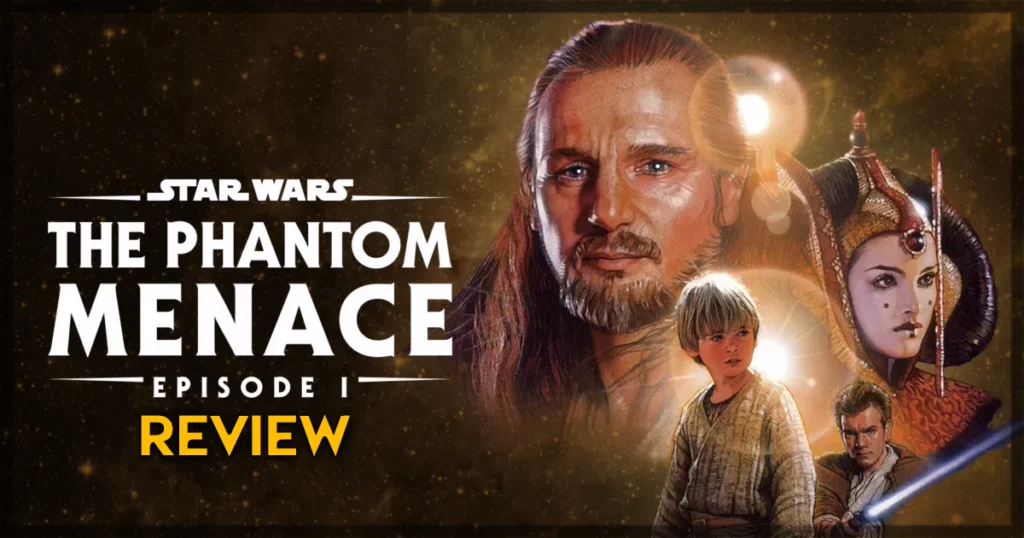Revenge of the Sith is the best of the Star Wars prequel trilogy by a country mile. Where The Phantom Menace and Attack of the Clones felt narratively meandering, handicapped by their insistence on telling over showing, Revenge of the Sith takes much better advantage of writer-director George Lucas’s idiosyncrasies. There are still issues, but the film is nonetheless epic in scale and compelling in theme.
Three years into The Clone Wars – the galaxy-wide conflict that began in Attack of the Clones – Anakin Skywalker (Hayden Christensen) has become a respected military general. He keeps his marriage to Padme Amidala (Natalie Portman) secret from everyone, including his mentor and friend Obi-Wan Kenobi (Ewan McGregor), all while playing the role of Jedi Knight. The opening sequence even details a thrilling rescue of Republic Chancellor Palpatine (Ian McDiarmid), which puts Anakin’s heroics on full display. However, Anakin struggles to hide his emotional attachments from the Jedi Order, who would expel him if his secrets were discovered.
When Anakin has dreams of Padme dying in childbirth, a vision that could come true due to Padme’s recent pregnancy announcement, he vows to stop this from becoming a reality. He lost his mother after similar dreams and cannot imagine losing Padme too. His drive to save her, no matter what the Jedi may do, drives him straight into the open arms of Palpatine, who reveals himself as the Sith Master Darth Sidious. Having worked for years to undermine democracy and install himself as dictator, Sidious’s plan is almost complete, with Anakin serving as the final piece. The film details Anakin’s embracing of the dark side of the Force, becoming the iconic villain Darth Vader.
At its core, the original Star Wars film captured so many imaginations because it was a simple story of good versus evil to the backdrop of intergalactic spectacle. After two films of convoluted plotting, Lucas returns to a simple story, this time telling a tale on one’s descent into villainy. While there are plenty of sweeping battles, political sequences and majestic setpieces, it’s all in service to this story of corruption and entitlement. This not only makes Revenge of the Sith easier to follow than its fellow prequels, but adds weight and impact to the themes explored.
Some argue that Anakin’s transformation is underwhelming, namely due to how suddenly it seems to occur. I would retort that it’s not merely one thing that converts him to the dark side, but an amalgamation of elements that converged into a tipping point. Even as a boy, Anakin harbored sensationalized ideas of heroism that had festered from his time in slavery. When he was brought into the Jedi order, Anakin was groomed as a prophesied Chosen One, fueling his egotistical ideas. Yet he was also told to reject emotional attachments – whether pre-existing like with his mother, or new like with Padme. As such, his ideas of exceptionalism inflame his inability to handle loss, making him more likely to fly off the handle when his attachments are threatened, as demonstrated with his mother’s death in the last film. Add on Palpatine whispering in his ear about how the Sith can give him all he seeks, and you have a recipe for evil to emerge from the shadows of good intentions.
This is what makes Anakin’s character arc in this film so captivating. Story analysts like John Yorke and K.M. Weiland often measure character arcs in terms of what a character wants versus what they need. Anakin wants to become powerful so he may save Padme, but what he needs is to let go of his supremacist ideas. Palpatine’s corruption, the Jedi’s flaws as an order, and Anakin’s own arrogance all prevent this. Thus, by refusing what he needs, Anakin cannot get what he wants despite the terrifying power he obtains through the Sith. The execution is gradual, using small details like Anakin’s overly emotional ways, or the Jedi denying him the rank of master to build to the horrifying turn, enacted during the midpoint. This lends an air of tragedy to the film’s narrative, which becomes all the more melancholic when considered within the context of the entire prequel trilogy, and even the additional stories of The Clone Wars animated show (2008-2020) if one wants to include them.
Placing this arc alongside Palpatine’s plot to turn the Republic into a dictatorship – which will become the Galactic Empire featured in the originals – further explores how disillusionment with government systems can be just as harmful to democracy and individualism as entitled exceptionalism. These are interesting themes examined alongside some terrific filmmaking. While the CGI has aged poorly – the constant use of greenscreen has become especially noticeable – Lucas’s signature imagination remains intact, whether it’s the different planetary environments, the huge scale of the action, or the awesome character design of the droid General Grievous (Matthew Wood). John Williams’ score once again incentivizes the film’s immersive appeal, his use of operatic choirs echoing tragedy and horror. There is even a return to Lucas’s impeccable ability to showcase character through visuals – one of the film’s best scenes being a silent shot-reverse-shot sequence in the midpoint. Anakin and Padme look towards each other from across the city of Coruscant, showcasing the depth of their connection and ultimately leading Anakin to silently make his “deal with the devil” decision. It took three films but it’s so refreshing to see this trilogy properly utilize its visual medium.
Revenge of the Sith does occasionally fall into the same traps as its predecessors. The dialogue is more of a mixed bag than an outright flaw this time – the playful hokeyness both showcases the characters’ personas and inspires many memes – but some scenes, such as Anakin and Padme’s romantic exchanges, revert back to the schmaltzy overwriting that plagued the previous films. This occasionally affects the performances, namely Christensen, who’s a lot better than last time but still has trouble with Anakin’s emotional outbursts when he turns evil.
Lucas’s dialogue and direction is, in fairness, more to blame for this than Christensen, whose facial expressions do a lot to sell Anakin’s anguish and growing resentment. The obvious effects may prove too distracting for some and the fight choreography does get so overblown at times that it looks more like hyper-stylised dancing than fighting. Padme is sadly relegated to a supporting character for much of the film, her own agency feeling lost in service to Anakin’s arc where other characters’, be it Obi-Wan, Yoda (Frank Oz), or even Palpatine, feel like they have their own journeys. In particular, the resolution to Padme’s story feels cheap, even lazy.
But, when taken as a whole, Revenge of the Sith proves a riveting addition to the saga. As vitriolic as much of the contemporary criticism to this trilogy was, Lucas does seem to have taken some of the negative feedback on board when crafting this picture. How else to explain the mostly improved story and characterization while retaining the creative spectacle and core themes on how suppressed emotions lead to destruction? It harkens back to the qualities that made the original film so engrossing – namely, its visual splendor and celebration of how anyone is capable of heroics – while sharing the more disquieting story that anyone is also capable of great evil. It’s a brilliant conclusion that, despite rough patches, ultimately succeeds in selling tragic themes and thrilling sci-fi entertainment.
The Star Wars prequel trilogy is an even set of films to put it mildly. It boasts spectacle, imagination and thematic richness, yet is rather clumsy in delivery, owing to a visionary director who perhaps needed more reigning in from those around him. While some of the revisionism that exists around these films today is clearly disingenuous malice, serving as a means to childishly attack the Star Wars sequel trilogy (2015-2019), the prequels are also, as a collective, better than they often get credit for. Beneath its clunky writing and overreliance on CGI is a powerful core theme on fear and how unnurtured emotions can lead to horrific downfalls, whether of the self or entire societies. Whatever its faults, there is no denying this trilogy’s ambition. The journey has its fair share of turbulence, but Revenge of the Sith poignantly sticks the landing with its immersive filmmaking and grandiose setpieces. It is a satisfying conclusion and a solid springboard into what follows next – the beloved original trilogy that we all love.
4 stars
Star Wars: Revenge of the Sith is streaming on Disney+.
Learn more about the film, including how to watch it, on the Disney+ site.
You might also like…
Star Wars: The Phantom Menace – Sci-Fi Fun That’s Rough Around the Edges


